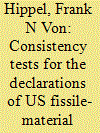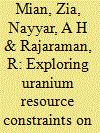| Srl | Item |
| 1 |
ID:
124853


|
|
|
|
|
| Publication |
2013.
|
| Summary/Abstract |
The uranium-235 content of a uranium enrichment plant's product is related to the uranium-234 content of its waste, allowing one to check with tails measurements consistency with a plant's declared past production. Verification works best with known feed material, but with unknown feed isotopics the production of low and high enriched uranium may still be distinguished based on tails measurements. Estimating product masses is harder, and concealment scenarios are discussed. With traditional nuclear accounting, relationships between product and waste isotopics, or "nuclear archaeology," can increase confidence in the accuracy of declarations of past fissile material production.
|
|
|
|
|
|
|
|
|
|
|
|
|
|
|
|
| 2 |
ID:
104158


|
|
|
|
|
| Publication |
2011.
|
| Summary/Abstract |
In the 1970s and early 1980s, the United States Government released data on the history of its purchases of natural uranium, the amount of separative work done by U.S. uranium enrichment plants, and the fission energy released by U.S. production reactors. These data provided the basis of nongovernmental estimates in the 1980s of U.S. production of plutonium and highly enriched uranium. In 1996 and 2006, the United States published reports on its historical production of plutonium and highly enriched uranium respectively. This article presents a first rough analysis of the two sets of data and finds that they are reasonably consistent.
|
|
|
|
|
|
|
|
|
|
|
|
|
|
|
|
| 3 |
ID:
092913


|
|
|
|
|
| Publication |
2009.
|
| Summary/Abstract |
This paper evaluates possible scenarios for Pakistan's uranium enrichment and plutonium production programs since the late 1970s by using Pakistan's supply of natural uranium as a constraint. Since international sanctions have prevented Pakistan from importing uranium for decades, it has had to rely on domestic uranium production-currently estimated as approximately 40 tons a year. The paper divides the development of Pakistan's uranium enrichment and plutonium production programs into three broad periods: from the beginning in the late 1970s until the 1998 nuclear tests; from 1999 to the present; and from the present to 2020; and considers how Pakistan could allocate its domestic uranium between its uranium enrichment and plutonium production programs for each period. This assessment is completed for enrichment capacities ranging from 15,000 to 75,000 separative work units (SWU) and takes into account the construction of the second and third plutonium production reactors at Khushab. The study finds that Pakistan may have sufficient natural uranium to fuel the three reactors, if they are approximately 50 MWt each, but that for some of these enrichment capacities, there will be a shortfall of natural uranium by 2020. The paper considers the impact of alternative sources of enrichment feed such as depleted tails from previous enrichment activity and reprocessed uranium from low-burn-up spent fuel from the Khushab reactors. There are signs Pakistan early on may have enriched some reprocessed uranium, possibly acquired from China. It finds that by 2020, Pakistan could have accumulated approximately 450 kg of plutonium from the Khushab reactors and 2500-6000 kg of highly enriched uranium (HEU) (90 percent enriched) for enrichment capacities ranging from 15,000-75,000 SWU. These stocks would be sufficient for perhaps 100-240 simple fission weapons based on HEU and for 90 plutonium weapons. Pakistan may be able to produce more weapons if it either increases its rate of uranium mining or has more advanced weapon designs requiring less fissile material in each weapon.
|
|
|
|
|
|
|
|
|
|
|
|
|
|
|
|